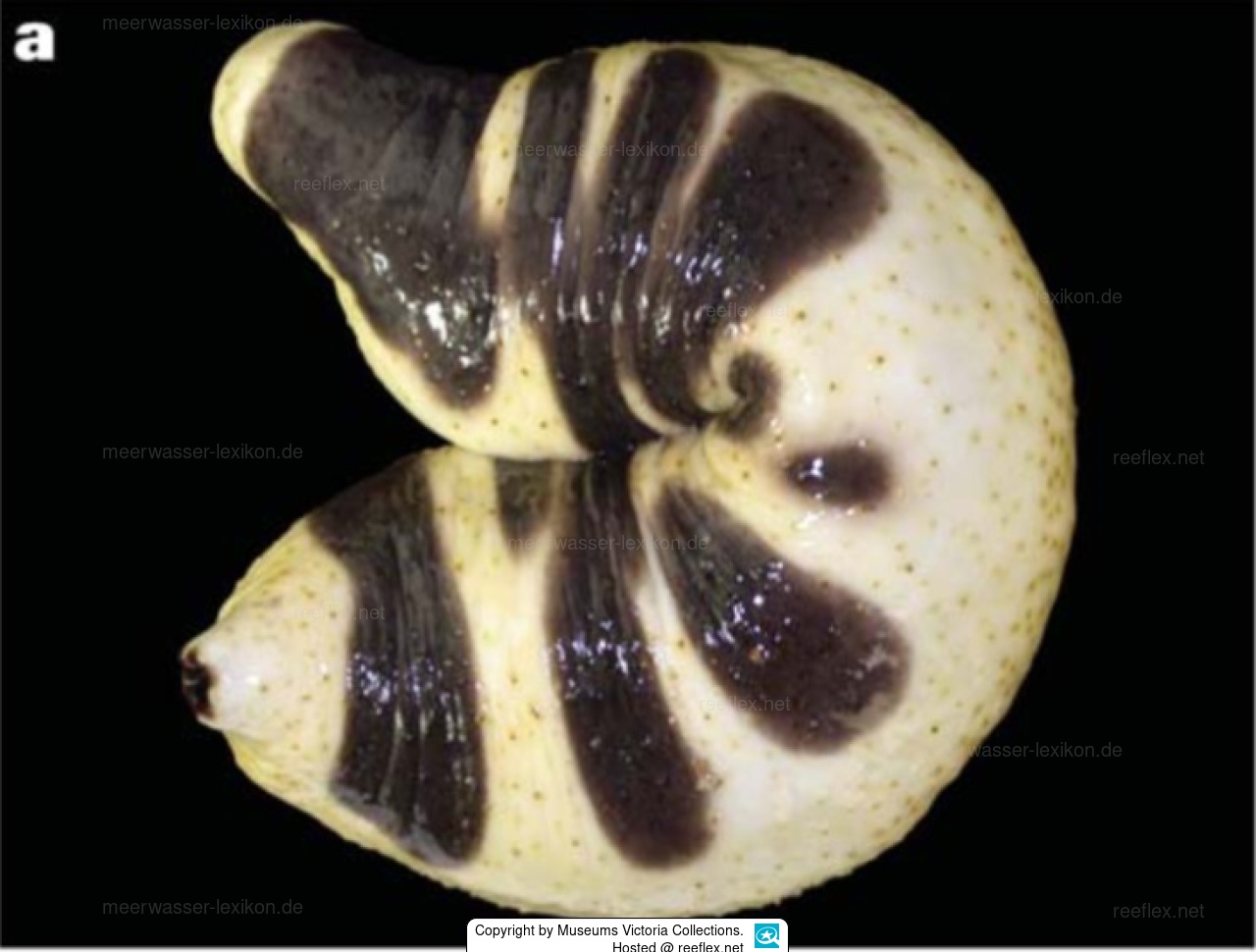Info
Holothuria (Halodeima) nigralutea is a first-collected deep-water sea cucumber observed in about 100 meters around Point Cloate, Western Australia.
The color of the living paratype) was black on pale yellow; with scattered small brown spots on the papillae.
Information on the biology of the sea cucumber is currently not available, certainly also due to the deep distribution of the species.
Etymology. From the Latin “niger” (black) and “luteus” (yellow), referring to the black and yellow life color.
Sea cucumbers of the family Holothuriidae possess, exceptions confirm the rule, so-called Cuvier's tubes (named after the French naturalist Georges Cuvier, * August 23, 1769 † May 13, 1832).
These are long, thin tubes that are located on the rectum of the echinoderms and are flung towards potential predators for defense.
These released tubes form a sticky, tough and stretchy network in which fish, crustaceans or other prey predators can become entangled.
The adhesives may also contain toxins (holothurin).
Sea cucumbers are the vacuum cleaners of the oceans, continuously cleaning the sea floors, so it may be useful for aquarists to keep one or more sea cucumbers in the aquarium to avoid detritus rich zones.
Problem:
Many sea cucumbers of the family Holothuriidae can release their venom into the aquarium water when they are in danger or dying, corals are mostly not harmed by the venom, but fish usually die.
Holothurins can cause severe, burning pain when in contact with the skin and irritation and even blindness when in contact with the eyes. When ingested systemically, the toxins can cause paralysis, muscle spasms, and discomfort in the digestive system, and in larger quantities, death by respiratory paralysis.
Since sea cucumbers are considered a delicacy in many Asian countries, the Cuvier's tubes containing the toxins must be removed before preparation or consumption.
Literature reference:
New Holothuria species from Australia (Echinodermata: Holothuroidea: Holothuriidae), with comments on the origin of deep and cool holothuriids
https://museumsvictoria.com.au/media/4103/64-o-loughlin-paulay-vandenspiegel-samyn.pdf
The color of the living paratype) was black on pale yellow; with scattered small brown spots on the papillae.
Information on the biology of the sea cucumber is currently not available, certainly also due to the deep distribution of the species.
Etymology. From the Latin “niger” (black) and “luteus” (yellow), referring to the black and yellow life color.
Sea cucumbers of the family Holothuriidae possess, exceptions confirm the rule, so-called Cuvier's tubes (named after the French naturalist Georges Cuvier, * August 23, 1769 † May 13, 1832).
These are long, thin tubes that are located on the rectum of the echinoderms and are flung towards potential predators for defense.
These released tubes form a sticky, tough and stretchy network in which fish, crustaceans or other prey predators can become entangled.
The adhesives may also contain toxins (holothurin).
Sea cucumbers are the vacuum cleaners of the oceans, continuously cleaning the sea floors, so it may be useful for aquarists to keep one or more sea cucumbers in the aquarium to avoid detritus rich zones.
Problem:
Many sea cucumbers of the family Holothuriidae can release their venom into the aquarium water when they are in danger or dying, corals are mostly not harmed by the venom, but fish usually die.
Holothurins can cause severe, burning pain when in contact with the skin and irritation and even blindness when in contact with the eyes. When ingested systemically, the toxins can cause paralysis, muscle spasms, and discomfort in the digestive system, and in larger quantities, death by respiratory paralysis.
Since sea cucumbers are considered a delicacy in many Asian countries, the Cuvier's tubes containing the toxins must be removed before preparation or consumption.
Literature reference:
New Holothuria species from Australia (Echinodermata: Holothuroidea: Holothuriidae), with comments on the origin of deep and cool holothuriids
https://museumsvictoria.com.au/media/4103/64-o-loughlin-paulay-vandenspiegel-samyn.pdf







 Museums Victoria Collections, Australien
Museums Victoria Collections, Australien


































